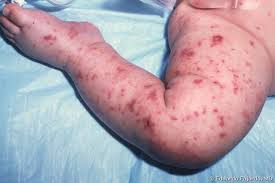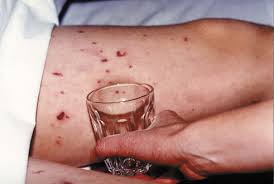Meningitis is a serious illness that occurs when the lining that covers the spinal cord and brain, known as the meninges, becomes inflamed. The cause of meningitis is usually due to a viral or bacterial infection.
Septicemia, or blood poisoning, occurs when a bacterial infection affects the blood. It is caused when bacteria in the body multiplies and sends toxins into the bloodstream.
Although meningitis and septicemia are two different diseases, those who are suffering meningococcal meningitis, the most common form of bacterial meningitis, may very well also develop septicemia.
What Is Meningitis Rash Like?
Developing a faint rash that resembles a bunch of very small pink, red or purple pinpricks with meningococcal meningitis is common. Initially, the rash may be mistaken as a bit of bruising, blotchiness, or a scratch. It can be visible on any location of the body.
As the patient becomes more ill and the infection more wide spread, additional bleeding takes place under the skin and the rash becomes more noticeable. It may get to the point where it looks like large bruises rather than a rash.
If the patient has darker skin, the rash will be easier to see on areas such as the inside of the mouth, the eyelids, or on the palm of the hand.
The Glass Test
One way to help determine if a rash is caused by meningococcal septicemia is to perform the ‘glass test’. Using a clear glass, press firmly against the area of the skin that is showing the rash. If the rash does not fade when pressed, the patient may have been infected with meningitis.
If the rash and a fever are present, seek emergency medical assistance.
Here are some pictures of meningitis rash:
Notes and Precautions
If you or someone else has signs of meningitis seek emergency medical assistance right away. Do not wait to see if a rash develops.
Viral meningitis develops more slowly than bacterial meningitis, which is more serious. Those infected with bacterial meningitis will likely experience symptoms suddenly and will become increasing sick quickly. The faster antibiotics are administered, the more likely complications will be avoided.
Other Common Meningitis Symptoms
Bacterial Meningitis
Bacterial meningitis is more likely to infect younger children under age 5 and babies. Symptom of meningitis you may notice in patients within this age group may include some or all of the following in any order:
- Not wanting to eat and vomiting
- High fever with hands and feet that feel cold
- Being lethargic and unresponsive
- Breathing or grunting quickly
- Having a high pitched cry or moan
- Being agitated and not wanting to be picked up
- Having a meningitis rash, as described in this article
- Having a stiff neck
- Being sensitive to bright lights
- Having convulsions or seizures
- In babies, having a bulging soft spot (fontanelle) at the top of the head
Symptoms older children and adults suffering from bacterial meningitis may experience include:
- Cold hands and feet along with a fever
- Drowsiness and having a hard time waking
- Irritability and confusion
- Vomiting
- Excessive muscle pain
- A meningitis rash
- Stiff neck
- Severe headache
- Being sensitive to light
- Seizures or convulsions
Viral meningitis
The symptoms of viral meningitis are usually similar to the flu, including:
- Fever
- Headache
- Generally feeling unwell
In severe viral meningitis, symptoms may include:
- Muscle or joint pain
- Neck stiffness
- Diarrhea
- Nausea and vomiting
- Sensitivity to light
Meningitis and septicaemia -- Watch the video to know the symptoms:
How to Treat Meningitis
After medical tests are performed and meningococcal meningitis is confirmed, antibiotics will be prescribed by IV, such as ceftriaxone or penicillin. Other medications may also be given, including steroids or drugs used to relieve pressure from spinal fluid.
Treatment for meningitis is different depending on whether it is viral or bacterial.
Viral Meningitis
Since antibiotics are not effective in treating viral meningitis, getting lots of rest and having someone help take care of you is important. Although viral meningitis usually doesn’t last very long, some people continue to be more tired than usual for a while or suffer from headaches.
Occasionally, encephalitis, which is inflammation of the brain, may occur with viral meningitis. In this case, antiviral treatment may be prescribed.
Bacterial Meningitis
If you are diagnosed with bacterial meningitis, you will need to begin IV antibiotic treatment right away. You will be admitted to the hospital, and possibly to the ICU if your infective is severe. You may also be given additional oxygen treatment.
Children with meningitis may also require intravenous feeding. Recovery time for bacterial meningitis can take anywhere from a week to a month or even longer.
If you or a loved one has come into contact with someone who has recently been diagnosed with meningococcal meningitis, be sure to see your doctor right away so that you don’t catch this serious infection. Common environments where you may pick up this contagious disease include daycare, school, home, or work.
How to Prevent Meningitis
A number of vaccinations are available in order to prevent certain types of bacterial meningitis and those meningitis rash as listed below.
- Haemophilus influenzae type b vaccine (Hib). This vaccine is included in the regular vaccination routine for children in the US beginning when they are 2 months old. Some adults are also given this vaccine, especially those who have been diagnosed with AIDS, sickle cell disease, or those without a spleen.
- Pneumococcal conjugate vaccine (PCV7). Children under the age of 2 are given this vaccine as part of their regular vaccination regimen in the US. It is also suggested for children between ages 2 and 5 who have certain medical conditions including cancer, lung disease or heart disease.
- Haemophilus influenzae type b and Neisseria meningitidis serogroups C and Y vaccine (Hib-MenCY). Children between the ages of 6 weeks and 19 months who have medical conditions that place them at risk for bacterial meningitis should be given this vaccine, such as those who have issues with their spleen or who have sickle cell anemia. The vaccine is given at 2, 4 and 6 months of age, and then again between 12 and 15 months old.
- Pneumococcal polysaccharide vaccine (PPSV). This vaccine is given to adults and older children who require additional protection from bacterial meningitis. It is recommended by the Centers for Disease Control and Prevention (CDC) that anyone over the age of 65 receive this vaccine. They also recommend it for younger adults and children who have certain medical conditions, including heart disease, sickle cell anemia, those without a spleen, those who have diabetes, and those who have a weakened immune system.
- Meningococcal conjugate vaccine (MCV4). This vaccine is recommended by the CDC for children at 11 or 12 as a single dose, followed up by a booster at 16 years of age. If the initial vaccine is not given until age 13-15, the booster should be given between the ages of 16 and 18. If the shot at 16 years or older, a booster is not required.
Children between the ages of 9 months and 11 years can also be given this vaccine if they have been exposed to bacterial meningitis or fall into a high risk category. This vaccine can also be used for older individuals who have not been vaccinated if they become exposed to the disease.
Reference: http://www.mayoclinic.org/diseases-conditions/meningitis/basics/prevention/con-20019713



